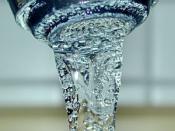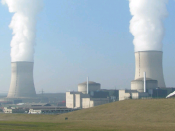Water - The Universal Life SourceWater is one of the most important active natural resources available and is an essential component for the sustainability of human life. Without the availability of the natural resource of water, plants and animals could not meet their minimum requirement to sustain life and would eventually die. Humans, animals and plants all depend on the resource of water for survival. Humans depend on water for a number of reasons such as cooking, irrigation to grow food, drinking, and cleaning. Energy and waste disposal use water. Considering water does not have an infinite supply, much of the water available on Earth contains a high level of salt preventing consumption for drinking, and irrigation, it is essential that the there is management of the water supply. Furthermore, infected water may occur in areas in which sanitation is not proper with diseases and parasites. Expectation as the population continues to grow that the world's water supply is to become scarce.
If proper management of the current water supply, freshwater will be a critical issue in the years to come. Numerous measures can by each individual to preserve the world's current precious water supply.
Importance of Water and Resources it ProvidesImportance of WaterWater has many valuable purposes. The obvious ones such as those pertaining to the human survival and there are the purposes as it applies to the ecosystem and its effects on nature. Most of society today takes water for granted. Humans turn on the faucet to allow the water to cold allowing them to have a cold drink of water. Humans fill bathtubs full of water to bath our children. In addition, there is continuous water usage when taking care of our landscaping needs. These many actions humans do every-day with use of water.
However, as far back as the Greeks, "â¦entire cities were built on the location of water." (Water Encyclopedia) The human body consists of 75% water. For humans if the water drops in the body more than .07% we can suffer possible dehydration. During Roman times, waters importance was so high that it was a crime to pollute it. However, how it applies to the role of the ecosystem is another important aspect.
Resources ProvidedWater provides the earth the necessary tools to support and sustain life for several organisms. Water is a renewable source, with many parts of the earth containing water such as oceans, rivers, seas, ice caps, lakes, and the ground. However, even though water is a renewable source not all areas that contain water renew rapidly. According to school of Oceanography some such as the ocean can take 2500 years to renew and ground water 1400 years; lakes can take 17 years to renew whereas soil moisture only one year and biological water only several hours. Therefore, human usage has a superior affect and impact on our water resources.
With the rapid population growth that the world is experiencing, resources such as at water are at risk. Humans use water for many resources and these resources are depleting our supply more rapidly than it can renew. These resources include agricultural, industrial, household, recreational, nuclear, and the environment. Agricultural uses estimated 69%" (Water Encyclopedia, 2009) of the earth's water today with industrial and household using 15 percent.
Nuclear PlantsOne of the big controversies of water usage is as it pertains to Nuclear energy. Arguments exist for and against nuclear plants. The arguments for are mainly due to the environmental impact on the earth, but also the amount of water needed to sustain the program. With the population increasing, there is a need for more nuclear plants to emerge to sustain the human need for higher standard of living. Nuclear power-plants do have their purpose; they produce energy. Energy is necessary because humans use it in their ever day life. In addition, there are positives in respect to the environment that use of nuclear power-plants has to offer. According to France, nuclear plants are responsible for a 40% decline of acid rain and carbon dioxide emissions. In addition, suggestion is that nuclear plants have not contributed to the global warming controversy. Moreover, nuclear power-plants do not release pollutants into the atmosphere. However, nuclear plants do have their controversy. The controversy is with nuclear power-plants and their water usage.
Nuclear plants use an abundance of water to steam and cool radioactive waste. In addition, primarily the water comes from lakes and rivers, which in turn affects life in these areas. In nuclear plants "â¦water pollutants, such as heavy metals and salts" (EPA, 2008) are in the water after build up. When the pollutants discharge, many aspects are affected including "â¦fish and other aquatic life." (EPA, 2008). With water resources yielding a renewable state on an average of 17 years for lakes alone it is no wonder why the controversy exists in respect to nuclear plants. However, as mentioned nuclear plants are a necessary for human survival and growth.
Availability of Water/Drought and Natural CyclesWater and drought go through a series of natural changes that include rain shift that will include global warming's, drier areas, wildfires, and challenges to the agriculture. The Dansgard -Oeshgeare rapid climate fluctuations, that occur after glacial periods. These features of climate change are evident in the availability of water resources.
In addition to the natural water cycle, there are manmade influences. For instance, scientists expect that when the population peeks in 2050 at about nine million people. "The number of people living in water- stressed countries will increase from about 700 million today to more that 3 billion by 2055 (about 35% of the predicted global population." "There will such great demand for food to feed everyone and there will not be enough water to grow the food needed to meet the population growth and diet demands. More crops will be required with fewer drops." "55% of the world's population will be dependent on food imports by 2030 as a result of insufficient domestic water" (World Economic Forum, 2003)In the United States due to population boom in certain areas in many of the western states and in the southeast there is scarcity of water. The Southeast, for example, in the past 50 years there has been a large growth in population. It times of scarce rainfall there has been a serious water shortage. For instance, in October 2007 Atlanta Georgia had only 87 days of drinking water left. Raleigh, North Carolina had only 97 days left before their drinking water depleted.
In the United States we have notices a shift in the demand for water." With population growth increased by 20% and 15% increase in water consumption, the demand from traditionally large water supplies (ranches, mines and factories declined from that period. However, the drop from these traditional demands is offset by the demand for drinking water and water for keeping lawns looking green and lush." World Economic Forum's Water Initiative, 2003)Water quality and sanitation go hand-in-hand. Today, 1.1 billion people live without clean drinking water; 1.8 million people die every year from diarrheal diseases. Nine hundred children die each day from waterborne diseases. Poor quality of water is a political issue as well as an environmental one. "The global water crisis for the poor is rooted in power, poverty and inequality."(World Economic Forum's Water Initiative, 2003)In spite of the geological diversity of the US, no part of the country is immune to drought. Since 1996, a number of severe droughts have occurred with drastic environmental, economic, and social impact. Drought always increases in the summer when there is a greater demand for water.
In many parts of the world glaciers act as water banks, they feed rivers, and provide water supply. Today the glacier banks are melting three times the rate of the previous decade. This causes flooding. The seriousness lies ahead when the glacier banks are gone. Most analysis project this will be in 2100.
In addition to glacier reduction, there is expectation of climate change to increase the frequency and duration of droughts. Droughts cause lower reservoir levels, higher temperatures, and lack of precipitation.
In 1988, the Climate Prediction Center calculated that drought cost the United States $39 billion. Drought is costly to the United States in many ways. To prepare for drought, the federal, state and local governments need to work pro -actively with water managers. The Geological Society of America recommends that the US shift from a "crisis-based, reactive, drought management to risk-based pro-active drought management, with greater emphasis on drought monitoring and early warning, prediction, mitigation and preparedness planning."Society would benefit from the creation of a new water culture, which would promote sustainable water management goals The report states that encourages a "broad educational initiative that can foster partnership and collaboration among local, state, federal, and tribal governments, educational and research institutions, energy and industrial users, and the public. Increased public education may be the single most effective enabling element of long term drought mitigation and water resources management." (Geological Society, 2006)Worldwide, it is essential that countries take a broader and longer view about water's role in economic development. If a country wisely takes proactive management of water resources, it will minimize the economic, environmental and the social disruption of a future water crisis. Countries can encourage industries less dependent upon water. India, for instance is shifting from agriculture to communicationsPossible Resource Management & How it is being ManagedWater is a necessity for everyone humans daily consumption. Taking action and preventing waste including washing dishes, washing laundry, hand washing, bathing, and cooking. People do not realize how much water they use on a daily. According to a website, the average American uses 80-100 gallons of water per day.
Handling of water management occurs in several ways. According to one website, there are efficient products that consumers can purchase to help with the wasting of water so that we can help the environment. For, example, there are high efficient toilets (HET) that help to reduce the wasting of water per flush; showerheads, and faucets to reduce the flow and pressure of the water. Some other ideas that we can do to help with water management are, repair leaky faucets and drains, take short showers instead of baths, overwatering lawn, and only washing cars when necessary.
Dangers of not Enforcing Resource Management & Environmentalist ViewpointWater Crisis, Lack of Rain Fall, and DroughtMother Nature can provide all different kinds of resources to allow humans, plants, and animals to survive. What Mother Nature provides, in turn Mother Nature can take away if humans do not proceed cautiously. Many places in the world that have the abundances of water have no problems. In addition, conservative usage practices are needed in which places where water is scarce such as the dry and arid lands in the world. With the lack of rainfall, and continuous drought, water management plays an important role in our survival especially for regions stricken by the lack of rainfall, and drought that is causing its inhabitants to face water crisis.
Excessive Consumption of WaterHumans are guilty of excessive water consumption for centuries. In the modern era, we use water resource with disregard to the amount of time needed for Earth to replenish itself. With overpopulation, our drinking water resource is depleted at a raptly every day we are not being carful of our waste. Even with a pinhole leak from our pipes, gallons of water waste occur. Toilet flushing also takes an abundance of water resource usage daily. Flushing should occur when needed and not used to flush small items down or small amount of liquids in the toilet bowl. Car washing consumes large amounts of water. Instead of a hose, a bucket is wiser to use instead. The savings would turn out much better. Watering the lawn and garden also takes an abundance of water. Although going green helps Mother Nature preserve itself society needs to make sure they are not using water or any of the resource in excessive. Water usage should occur in moderation and more conservatively. Otherwise, water resource would end up scarce.
Endangerment of other Living Beings due to Water ShortagePlants and animals are the worst stricken by water shortage, and drought. Many animals have no means of being able to protect themselves from humans when trying to obtain water resources to drink. Some animals would come out from the wilderness to go to suburban locations to drink water. Some of them were shot in search of water because they are misunderstood of their purpose from coming out from the wilderness. Plants wait for Mother Nature to produce rain for replenishment. With the lack of rain, and continuous drought, underground water might not reach the roots of these trees and could cause a major catastrophe. Humanity, plants, and animals are interdependent with one another. We count on resources to remain abundance at all times. This could be a big assumption that we might regret once the resources refuse to replenish on its own.
Rule Making Authority to Save Water ResourceIn order for the planet to survive against over consumption of water, resources must be obtained from higher authorities. "As a result of rivalries, externalities, monopolies, and equity considerations, certain limitations to the exclusion principle are normally imposed. This calls for a superior authority establishing rules related to individual's rights of access to the resource and the management of water resources." (FAO, 2009). There has to be an authoritative office in charge of water preservation and usage. These offices must be in place in each country, states, regions, territories, counties and districts forth to oversee the usage of one of our most important resources. Authoritative importance given to the offices, so that actions against individuals or corporations that do not adhere to proper usage. Once control has occurred, the chances to avoid waste would be enormous.
ConclusionWater is a natural resource that has been here from the beginning of time. However, water is one of the world's natural resources that cannot replenish itself within a lifetime, or even a hundred lifetimes. Humans consume the majority of fresh water and therefore have a responsibility to protect this resource from misuse. Mother Nature does her part in providing this vital life source to us, it is up to us to keep water flowing and safe for all organisms on earth because in some way, we are all connected. Its importance can be seen in our every day lives; from the farms that use it to produce food, to the industrial plants that require water to have the machines function properly. To the nuclear plants that use water to cool the reactors, to the water that flows from our faucets into our glasses, water is a vital part of everyone's life.
97% of water on the Earth is salt water, leaving only 3% as fresh water of which slightly over two-thirds is frozen in glaciers and polar ice caps. The remaining unfrozen fresh water furnishes as groundwater, with only a small fraction present above ground or in the air (Perlman, 2009). Natural and man-made causes affect the availability of water. Population growth, expansion of business activity, and rapid urbanization are some of the manmade causes of water shortages; whereas climate change is an example of natural causes.
Resource management is the only possible method of controlling and preserving the consumption of this valuable resource. Cooperation between states in the contribution of water is a step toward reaching our goal of sustainable water management to meet society's needs. Current development is underway of a desalination process that can artificially produce fresh water at New Mexico State University. Acording to researchers there, it occurs with a low energy source like solar power (Hill, 2007).
Every living organism on earth has some connection to the next. The connection may be that it is prey or predator to the other. For this reason, it is one of the most precious natural resources there ever is properly managing. Without being properly management, there is an affect on living organisms; they might even perish. The excessive consumption of water by humans not only affects humans themselves, but it also harms the other organisms that depend on water as their life-source as well.
ReferencesEPA. (2008). WaterSense Looks to Cut Residential Water Use by 20 Percent. Retrieved from http://www.iapmo.org/Official%20Articles/2008-07%20Homes%20with%20a%20Higher%20IQ.pdfHill, Karl. (2007, May 29). Researchers develop low-cost, low-energy desalination process. Retrieved from http://www.nmsu.edu/~ucomm/Releases/2007/may/desalination_project.htmManaging Drought: A Roadmap for Change in the United States. The Geological Society of America. Retrieved from www.geosociety.org/meeting.2006Perlman, Howard. U.S. Department of the Interior, U.S. Geological Survey. (2009). Earth's water distribution Retrieved from http://ga.water.usgs.gov/edu/waterdistribution.htmlReform and Decentralization of Agricultural Services. Retrieved on November 3, 2009 from http://www.fao.org/docrep/005/y2006e/y2006e0f.htmSchool of Oceanography (2010) University of Washington. Period of renewal. Retrieved November 05, 2009 on the World Wide Web: http://www.ocean.washington.edu/courses/envir215/lecture14_powerpoint.pdfUS Environmental Protection Agency (2008, September) Nuclear Energy. Electricity from Nuclear Energy. Retrieved October 31, 2009 on the World Wide Web: http://www.epa.gov/RDEE/energy-and-you/affect/nuclear.htmlWater Encyclopedia (2009) Role of the water in the environmental movement. Retrieved October 31, 2009 on the World Wide Web: http://www.waterencyclopedia.com/Da-En/Environmental-Movement-Role-of-Water-in-the.htmlWorld Bank Group, The. (2009). Water. Retrieved from http://web.worldbank.org/WBSITE/EXTERNAL/TOPICS/EXTWAT/0,,contentMDK:21630583~menuPK:4602445~pagePK:148956~piPK:216618~theSitePK:4602123,00.htmlWorld Economic Forum (January, 2008) World Economic Forum Water Initiative. Realizing the Potential of Public-Private Partnerships Projects in Water. Retrieved on the World Wide Web: http://www.weforum.org/pdf/water/realizing.pdf


